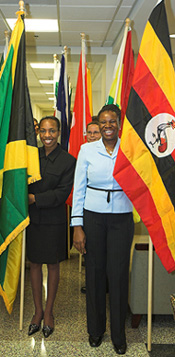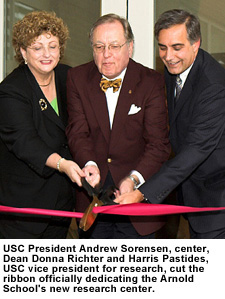


|
|
|
|
|
|
|
|
|
|
|
|
||||||||||||||
|
||||||||||||||
|
|
||||||||||||||
|
||||||||||||||
|
Posted 10/27/2006
Arnold School of Public Health dedicates
Each flag represented the home country of an Arnold School student or faculty member or a country where the school has research activities. “From these flags you can see our reach is broad. We are dedicated to improving heath statewide and worldwide,” Dean Donna Richter told a crowd of about 125 persons gathered in the first floor lobby because of rain. USC officials consider the five-story building to be the cornerstone of the university’s Innovista research campus. “Today, we see the realization of our plans and dreams to establish Innovista, where top scientists conduct research in areas as diverse as health, medicine, Future Fuels, nanotechnology and the environment,” said USC President Andrew Sorensen, whose own academic and professional career is in public health. The building, designed to follow the “green design” principles of the U.S. Green Building Council, will house research laboratories and programs of the departments of exercise science and environmental health sciences, as well as the Prevention Research Center and the Children’s Physical Activity Research Group.
The Arnold School’s research programs address some of the Palmetto State’s most serious problems: obesity, diabetes, physical inactivity, the environment and cardiovascular diseases. Richter said the new building is a testament to the progress in public health teaching, research and outreach. “When this school was established only three decades ago, no one could have foreseen the public health problems and threats that we would face in the 21st Century,” said Richter, who is internationally recognized for her work in HIV/AIDS education and prevention. “Public health has confronted the spread of HIV and AIDS, the threats of bioterrorism and the challenges presented by an increase in obesity, cardiovascular disease, diabetes and cancer. Yet, with each of these challenges, the Arnold School of Public Health has adapted its education, research and outreach missions to meet the healthcare needs of our state and nation.” Norman Arnold said the building signals a new era in public health at the university. “I am a committed supporter of this school,” said Arnold, a survivor of pancreatic cancer. “I am alive today because so many others devoted their lives and intellect to discoveries that affect the health of people in need. The opening of this new public health research center has the potential to lead to advances that will change the lives of millions of people.” The Arnold School dedication also included the unveiling of “Anne’s Garden,” named for Anne Edens Rainey of Columbia, a USC alumnus and founder of Columbia Green, a civic beautification organization. The centerpiece of the garden is a bronze fountain called Las Palomas, sculpted by Sandy Scott, recognized as one of the country’s premier animal sculptors. John Rainey commissioned the fountain as a surprise for his wife, known as an outstanding perennial gardener. For more information: •
Arnold School of Public Health, www.sph.sc.edu.
Arnold School Fact Sheet The Arnold School of Public Health was established in 1975. It is the only school of public health in South Carolina and is one of 38 schools of public health in the nation. The first dean was Dr. Winona Vernberg, who served for 18 years. Other deans include Dr. Harris Pastides, USC’s vice president for research and health sciences, and Dr. Donna Richter, who joined USC’s public health faculty in 1983 and was named dean in 2005. The school is named for Columbia business leader Norman J. Arnold and his wife, Gerry Sue. The couple gave $10 million to USC in 2000. The Arnold School of Public Health has 95 faculty, 479 graduate students and 413 undergraduates. The school offers 21 master’s degree programs and 11 doctoral degree programs, as well as a bachelor’s degree program in exercise science. Among the Arnold School’s centers and programs:
•
Prevention Research Center The Arnold School of Public Health was the first school of public health to have a department of exercise science. The move to establish the department was early recognition by faculty that physical activity plays an important role in health. Two exercise-science faculty members have served as president of the American College of Sports Medicine, and a third, Dr. Larry Durstine, chairman of the department of exercise science, is the current president of ACSM; Dr. Russ Pate, a professor of exercise science and USC associate vice president for health sciences, and Dr. Steven Blair, a professor of exercise science and the former president and CEO of the Cooper Institute in Dallas, Texas, a former president. |
| Columbia, SC 29208 • 803-777-7000 • sphweb@gwm.sc.edu | © University of South Carolina Board of Trustees |

 With a colorful show of flags from 49 counties, the University of South
Carolina Arnold School of Public Health dedicated its $22 million,
104,860-square-foot research center on Friday.
With a colorful show of flags from 49 counties, the University of South
Carolina Arnold School of Public Health dedicated its $22 million,
104,860-square-foot research center on Friday.  Named for benefactor Norman J. Arnold and his wife, Gerry Sue, the
Arnold School of Public Health was established in 1975 and is the only
school of public health in South Carolina.
Named for benefactor Norman J. Arnold and his wife, Gerry Sue, the
Arnold School of Public Health was established in 1975 and is the only
school of public health in South Carolina.